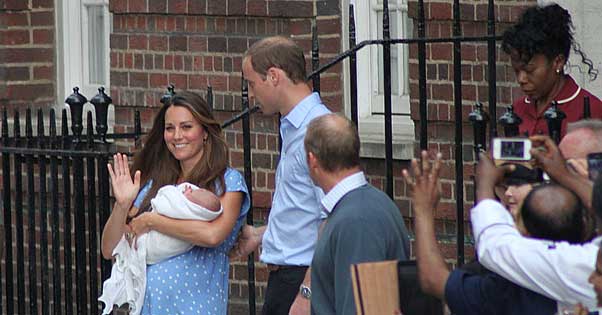
Josie Glausiusz is on hiatus and will return next week. This week, we return to one of her previous On Science essays.
Watching Kate and William emerge from St. Mary’s Hospital in London on July 23, 2013, with their little princeling, I couldn’t help feeling moved. The young Duke and Duchess of Cambridge looked happy, describing themselves, in Kate’s words, as “very emotional … any parent probably sort of knows what this feeling feels like.” Their blanket-bundled baby—His Royal Highness Prince George Alexander Louis of Cambridge—looked cute. The new family seemed so normal—or as normal as you can be when your newborn’s image is sent around the world.
Amid all the hoopla—the 41-gun salute in Green Park, the fevered speculation about the future king’s name—one question has not been officially answered: Is Kate breastfeeding? This is absolutely none of my business, and yes, her baby will be perfectly healthy whether or not she nurses. But I am shamelessly leaping upon the Royal Baby bandwagon to delve into some recent and important news on the biology of breast milk.
It is already well-known that breast milk can help protect a baby from stomach viruses, ear infections, and respiratory illnesses, and that’s because colostrum—the first milk produced by the mother—contains large amounts of an immune factor called secretory immunoglobulin A (IgA) that coats membranes in the baby’s gut, nose, and throat and protects the infant from pathogens. Breastfeeding is great for the mother as well: When she nurses, she releases oxytocin, a hormone that promotes nurturing and helps her relax.
Recent studies have also revealed that breast milk is much more than a simple fat, protein, sugar, mineral, and vitamin-stocked liquid. In fact, it’s more like yogurt, containing more than 700 species of bacteria. In addition, breast milk contains about 200 sugars called oligosaccharides that are indigestible to babies. But beneficial gut bacteria can easily break them down, so it’s thought that the sugars serve as food for intestinal microbes such as Bifidobacterium longum, sub-species infantis. Proteins in the cell walls of B. infantis help these bacteria grab the oligosaccharides for food, and also help the microbes grip sugars protruding from the surface of an infant’s intestines—thus enabling B. infantis to out-compete dangerous, diarrhea-inducing bacteria.
Research has shown that mucins—long, thread-like proteins that are the main component of mucus—are abundant in breast milk, and can protect infants against viruses such as diarrhea-causing rotavirus as well as HIV, perhaps because the viruses are trapped and entangled in the mucus. A recent study by Columbia University researchers showed that HIV-infected mothers in sub-Saharan Africa who breast-fed exclusively for more than the first four months of their babies’ lives had the lowest risk of transmitting the virus to their babies, compared with those moms who stopped nursing before four months. That’s probably because breast milk contains crucial immune factors that protect babies from infection.
So I do hope that the Duchess of Cambridge decides to breastfeed, and that she gets the help that she needs from her family and friends, because, speaking from experience, I know that nursing doesn’t always come naturally or easily. I also know that little Prince George will receive the best care and love from his devoted parents, whatever they decide.

